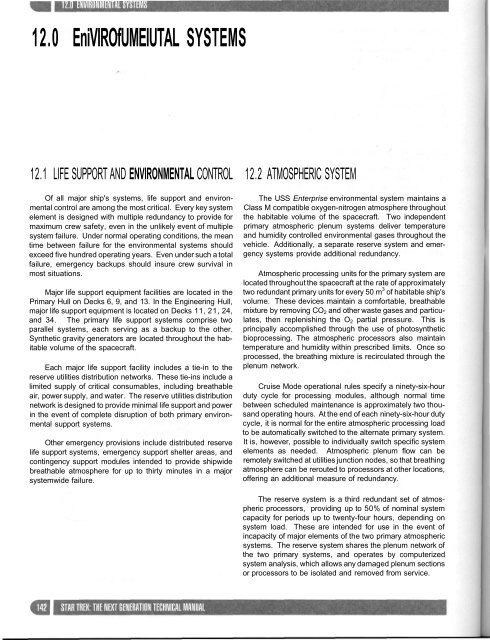franchise-star-trek-tng-technical-manual1
franchise-star-trek-tng-technical-manual1
franchise-star-trek-tng-technical-manual1
You also want an ePaper? Increase the reach of your titles
YUMPU automatically turns print PDFs into web optimized ePapers that Google loves.
12.0 EniVIROfUMEIUTAL SYSTEMS12.1 LIFE SUPPORT AND ENVIRONMENTAL CONTROL 12.2 ATMOSPHERIC SYSTEMOf all major ship's systems, life support and environmentalcontrol are among the most critical. Every key systemelement is designed with multiple redundancy to provide formaximum crew safety, even in the unlikely event of multiplesystem failure. Under normal operating conditions, the meantime between failure for the environmental systems shouldexceed five hundred operating years. Even under such a totalfailure, emergency backups should insure crew survival inmost situations.Major life support equipment facilities are located in thePrimary Hull on Decks 6, 9, and 13. In the Engineering Hull,major life support equipment is located on Decks 11, 21, 24,and 34. The primary life support systems comprise twoparallel systems, each serving as a backup to the other.Synthetic gravity generators are located throughout the habitablevolume of the spacecraft.Each major life support facility includes a tie-in to thereserve utilities distribution networks. These tie-ins include alimited supply of critical consumables, including breathableair, power supply, and water. The reserve utilities distributionnetwork is designed to provide minimal life support and powerin the event of complete disruption of both primary environmentalsupport systems.Other emergency provisions include distributed reservelife support systems, emergency support shelter areas, andcontingency support modules intended to provide shipwidebreathable atmosphere for up to thirty minutes in a majorsystemwide failure.The USS Enterprise environmental system maintains aClass M compatible oxygen-nitrogen atmosphere throughoutthe habitable volume of the spacecraft. Two independentprimary atmospheric plenum systems deliver temperatureand humidity controlled environmental gases throughout thevehicle. Additionally, a separate reserve system and emergencysystems provide additional redundancy.Atmospheric processing units for the primary system arelocated throughout the spacecraft at the rate of approximatelytwo redundant primary units for every 50 m 3 of habitable ship'svolume. These devices maintain a comfortable, breathablemixture by removing CO 2 and other waste gases and particulates,then replenishing the O 2 partial pressure. This isprincipally accomplished through the use of photosyntheticbioprocessing. The atmospheric processors also maintaintemperature and humidity within prescribed limits. Once soprocessed, the breathing mixture is recirculated through theplenum network.Cruise Mode operational rules specify a ninety-six-hourduty cycle for processing modules, although normal timebetween scheduled maintenance is approximately two thousandoperating hours. At the end of each ninety-six-hour dutycycle, it is normal for the entire atmospheric processing loadto be automatically switched to the alternate primary system.It is, however, possible to individually switch specific systemelements as needed. Atmospheric plenum flow can beremotely switched at utilities junction nodes, so that breathingatmosphere can be rerouted to processors at other locations,offering an additional measure of redundancy.The reserve system is a third redundant set of atmosphericprocessors, providing up to 50% of nominal systemcapacity for periods up to twenty-four hours, depending onsystem load. These are intended for use in the event ofincapacity of major elements of the two primary atmosphericsystems. The reserve system shares the plenum network ofthe two primary systems, and operates by computerizedsystem analysis, which allows any damaged plenum sectionsor processors to be isolated and removed from service.


